

Where is Florida's coral reef?
FLORIDA KEYS REEFS
North America's only living coral barrier reef lies approximately six miles seaward of the Florida Keys in water that are typically fifteen to thirty feet deep. The reef tract starts near Miami and extends southwest to the Dry Tortugas, about sixty-seven miles west of Key West. Patch reefs continue up through Dade, Broward and Palm Beach counties. Some considered the reef to be the third longest coral barrier reef in the world, after Australia and the Meso-American reef off Belize. However, barrier reefs in Cuba (Arecifes Colorados) and the Bahamas (Abaco) also claim the title of third longest barrier reef.

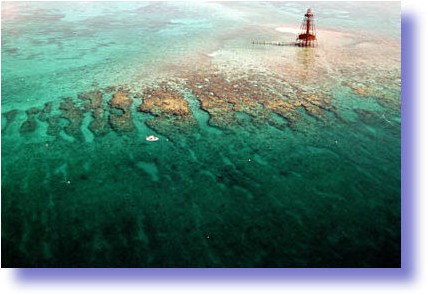
Photo by Craig Quirolo
Sand Key Lighthouse Reef. Note the spur and groove formations of the reefs.
Why is Florida's coral reef important?
The great coral reefs of the Florida Keys are the only true coral reefs in the continental waters of the United States. The Florida reef tract, composed of outer reefs and patch reefs, contains over fifty species of corals comprising over eighty percent of all the coral reef species in the Tropical Western Atlantic and over one hundred fifty species of fish. Florida's commercial fishery for spiny lobster and stone crab is the largest in the state. Tourism based on boating, diving, and fishing bring in millions into Florida's economy.
Why does Florida's coral reef need protection?
Heavy Use
The Florida Keys hosts several million snorkelers, divers, fisherman and boaters every year. So many people have become captivated by coral reefs that Florida is the number one dive destination in the world with ten times the number of the second highest rated diving area, Australia, an area of reef ten times larger. The coral reef is being destroyed by the sheer numbers of visitors. The physical impact of so many boats, divers and fishermen is rivaled only by the impact of the land-based development that supports such activities.
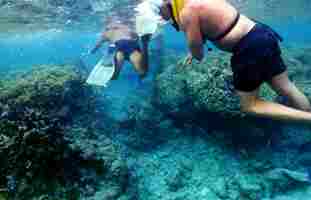
Photo by Craig Quirolo
Standing, Touching, Anchoring
Even the slightest touch can crush the fragile living coral polyps on the surface of each coral formation, exposing the entire coral head to infection and disease. Reef visitors that touch, stand, or scrape the coral with fins, hands or equipment damage coral that has grown for hundreds of years. Corals typically grow only one-half inch per year. The scrape of a fin can introduce bacteria that may lead to the death of a coralhead that is hundreds of years old.
Boat Anchors
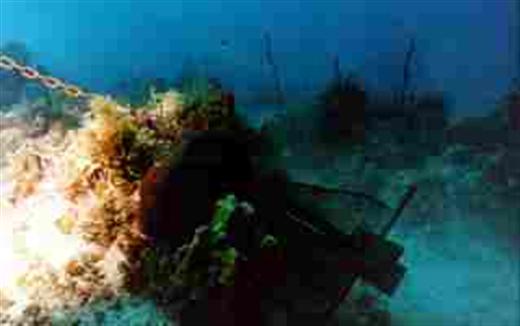
Photo by Craig Quirolo
Anchors destroy wide areas of coral by the sheer impact. The living coral polyps are crushed. Once damaged, corals living in waters that are less than pristine are easily overcome with nuisance algae that outcompetes the corals for habitat, causing infections and coral disease, leading to the demise of the entire coral formation. Anchor in sandy areas, away from coral and rubble areas of the reef. Use reef mooring buoys, if available.
Boat Groundings and Propeller Damage
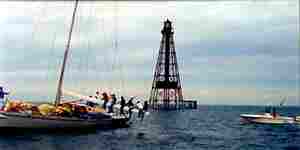
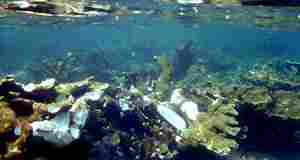
Photos by Craig Quirolo
Centuries of coral growth can be broken into fragments in the first moments of collision with a big large ship. Living coral is crushed by the sheer weight of the vessel. Cargo or fuel spilled onto the reef can do additional damage. Large freighters and ships that accidentally run aground get the most attention for killing large areas of coral reefs. But just as threatening are small pleasure boats that are literally chipping our reefs to death by groundings, propeller damage, and poor anchoring procedures. The cumulative effect of small boat groundings is just as harmful. Every year sanctuary officials report literally thousands of small boat groundings in the Florida Keys and there are more registered boats in the Keys than any other county in Florida, in addition to many more visiting and transiting vessels. An Area to be Avoided helps keep large freighters and tankers off the reef tract.
Prop Dredging
Prop dredging occurs when boaters enter shallow waters and their propellors stir up the bottom sediments. At best, this leaves a milky white trail of calcium carbonate silt, blocking sunlight and smothering bottom-dwelling organisms. Propellers also often uproot and shred seagrasses and cut channels in the seagrass beds that may never grow back. Straying from marked channels in the Florida Keys leads inexperienced boaters to shallow water where boats easily impact the bottom.
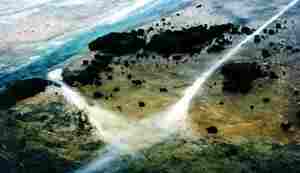
Photo by Curtis Kruer
Oil Pollution
Oil pollution from bilge discharge, untreated sewage from liveaboard and pleasure boats, and increased turbidity from boat wakes reduce the conditions required for healthy coral growth: clear clean, nutrient-free waters. Hydrocarbons pollute the water column and are taken up into the food chain.
What is the biggest threat to the health of Florida's Coral Reef?
WATER QUALITY DECLINE
Corals require clean, nutrient-free waters to thrive. A healthy coral reef has from 30-40% live coral coverage. However, in the Florida Keys, coral coverage is now reduced to an alarming 3%. Coral spawning has been reduced due to lack of healthy coral colonies and clean water.
The over-abundance of nutrients in the ocean is the single biggest threat to Florida's coral reefs. Nutrients is a scientific term for organic and inorganic materials that can include phosphates, and/or nitrates, usually from untreated and partially treated sewage, fertilizers and other pollutants. They promote algal blooms which rob the water of oxygen and compete with corals for habitat. Every year, 700 tons of nutrients are discharged into Keys waters from agricultural run-off from the Everglades. Another 33 tons of land-based sources of pollution are discharged from the landbase in the Keys, primarily from inadequately treated sewage and stormwater. Harmful algal blooms can result in eutrophication, when oxygen levels become so low that fish and other marinelife cannot survive.
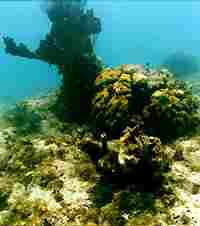
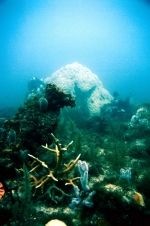
Photos by Craig Quirolo
Above: Left: Nuisance algae on the reef. Right: Bleached coralhead, algae in second image.
Below: White disease on boulder coral.

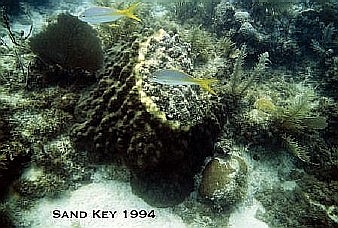
Photos by Craig Quirolo
Left: White disease on coral. Western Dry Rocks. Right: Yellowband disease, discovered by Craig Quirolo at Sand Key reef, Key West.
Today, ocean acidification is part of the problem as well. Carbon dioxide from the atmosphere is uptaken into the ocean, affecting the calcareous growth of the coral skeletons, reducing their strength by making them thinner and more brittle and prone to damage.
And warming sea oceans increase the proliferation of nuisance algae blooms and coral bleaching. Bleaching is a sign of coral stress, however, unless it lasts for longer than about 6 weeks, the corals can return to a healthy state when sea conditions return to normal temperatures. Coral diseases, however, are fatal.
This combination of stressors is causing corals to become diseased -- black, white and yellow band diseases are common at local reefs along with the aspergillosis fungus that attacks purple sea fans. Nuisance algae have replaced areas where corals once thrived. Visibility has dropped. In 1995, there were only 20 days when visibility exceeded 80 feet at Key West-area reefs. Just a few years ago, visibility at Keys reefs used to be over 100 feet and we referred to them as "gin clear." Even the new wreck in the Florida Keys-the Vandenburg--can only be viewed with underwater lights when you are immediately upon it, due to poor visibility.
Florida Keys coral reefs have undergone what scientists call a phase shift, where hard corals have been largely replaced by soft corals and sponges that tolerate poor water quality. The physical structure of the reef is changing as the rocky coral formations are replaced by dead boulders, encrusting sponges and algae, leaving less habitat for all the sealife that depends upon the reef structure.
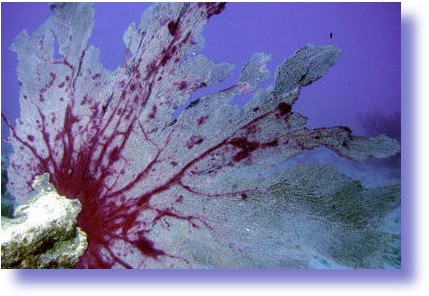
Aspergillosis on Purple Sea Fan. Photo by Craig Quirolo
Sources of Nutrients
Primary Causes: septic tank leakage, wastewater outfalls, fertilizers, pesticides, phosphate-laden cleaning products, stormwater run-off, and agricultural run-off. The porous limestone bedrock of the Florida Keys provides inadequate depth for most of the 25,000 septic systems in use in the Keys, many of which were constructed with no bottom. Effluent often discharges into nearshore waters and canals, leaching nutrients into the water and reducing water quality.
Throughout Broward, Palm Beach, Dade and Palm Beach counties, major wastewater plants dump inadequately-treated wastewater onto coastal areas and coral reefs via ocean outfalls. Recent legislation promoted by Reef Relief and the Florida Ocean and Coastal Coalition requires that they be replaced with advanced wastewater treatment and reuse.
Package plants throughout the Florida Keys provide sewage treatment for restaurants, camp grounds, condominiums, trailer parks and other facilities throughout the Florida Keys. They lack nutrient-removal tertiary treatment and release millions of gallons of nutrient-laden wastewater into nearshore waters through shallow injection wells. These "boreholes" are shallow holes encased to 60' and drilled to a minimum of 90' into which partially treated sewage is pumped. The porous limestone bedrock of the Florida Keys allows this sewage to travel laterally and rise up in fresh water aquifers or into shallow nearshore waters and at the reefs. Florida is the only state that permits shallow injection of sewage. Monroe County has more than 700 shallow injection wells and has taken action to replace as many as 7,000 illegal cesspits. REEF RELIEF's Paul G. Johnson and DeeVon Quirolo approached the state to upgrade the rules governing shallow injection wells many years ago. The approved rule for Monroe County (Florida Keys) requires that the effluent "neither degrade, nor contribute to the degradation of Outstanding Florida Waters." However, this rule hasn't been enforced.
Phosphate-laden cleaning products, fertilizers, and agricultural run-off from Florida Bay are other sources of nutrients. A phosphate ban instituted by Reef Relief helps reduce the amount of phosphates in cleaning products throughout the Florida Keys.
Pesticides
Pesticides are suspected of slowing the growth and interfering with the reproduction of corals. DDT is known to reduce photosynthesis in plankton. Endosulfan has been found in Florida Bay from Everglades agricultural areas. Pesticides persist for years in the tissues of marine organisms or become entrapped in marine sediments. An obvious source of pesticides is aerial spraying of mosquito control, which occurs as frequently as twice a week during the rainy season throughout the Keys. The run-off from lawns and agricultural areas also dumps pesticides into Keys waters.
Sedimentation From Development
Much of the bottom sediments of the Florida Keys are very fine silts of calcium carbonate. Composed of fine particles, these silts are easily brought into suspension through the construction of seawalls, canals, docks, and other construction on the shore. Sedimentation turns the water milky and when carried out to the reef, such turbidity inhibits the photosynthesis required for coral growth.

Sediment can destroy a reef. Photo by Craig Quirolo
Offshore Oil & Gas Development
Offshore oil drilling in the Florida Keys is prohibited by law as part of the designation of the Florida Keys as a national marine sanctuary. However, the Gulf Loop Current in the Eastern Gulf of Mexico could carry toxic drilling muds and any spills directly into the Florida Keys. Hydrocarbon pollution smothers fragile corals, fish, mangroves, seabirds, turtles and other marinelife and reduces water quality conditions. Louisiana has lost miles of coastal wetlands due to hydrocarbon pollution that has resulted in erosion.
We worked for many years to prevent the planned development of 73 leases for offshore oil held by nine oil companies for areas as close as 25 miles from Key West in the Eastern Gulf of Mexico. To secure annual Congressional moratoriums on their development, Reef Relief worked with a national coalition of activists-the OCS Coalition, and provided information and performed grassroots organizing for public hearings, petition drives, legislative visits, task force reports and related events. President George H. Bush declared a ten year ban on offshore oil drilling that President Clinton extended for another 10 years. However, George W. Bush transferred Lease Sale 181 to the jurisdiction of Louisiana, and it is being developed in the Eastern Gulf along with many other leases. The oil industry has also approached the Florida Legislature and is attempting to move oil exploration and development closer to Florida's beaches, coral reefs, and valuable shorelines.
Marine Debris
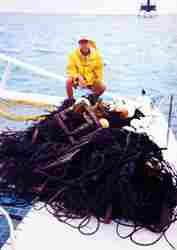
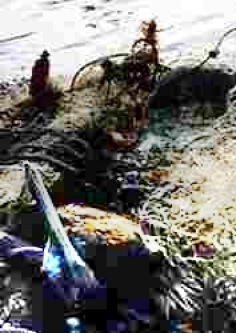
Left: Cal Harris brings in a fishing net during a reef trip.
Right: bird caught in net. Photo from Ocean Conservancy
More Than Just A Litter Problem! The Florida Keys has more marine debris than any other part of the United States. See recent article by DeeVon Quirolo.
Sources of Marine Debris
- Heavy Tanker and Cruiseship traffic in the Gulf Stream
- Commercial Fishing Industry
- Recreational Boaters
- Sportfishing and Diving Charterboats
- Military Vessels
- Oil Drilling vessels and platforms
Merchant Ships alone dump more than 5.6 million metric tons of dunnage, shoring, pellets, wires and covers into the ocean each year.
Impact of Marine Debris
Boats are damaged when propellers are fouled and cooling water intake systems are clogged by fishing nets, bags, sheeting and line. Clean-up procedures are costly and fisheries resources are depleted. Health Hazards Arise when infectious materials are carried ashore. The Real Tragedy is Marine Life. Hard and soft corals are torn by monofilament line, trap rope, and are smothered by plastic bags. Birds become entangled in monofilament fishing line and six-pack connector rings. They also ingest raw polyethylene pellets, the raw form of plastic after its synthesis from petrochemicals. Turtles commonly get caught in fishing gear. They ingest plastic bags which they mistake for their favorite food -- jellyfish. Manatees are caught in stone crab traps. Bottlenose dolphins and turtles become entangled in shrimp nets.
Fish Traps
Ghost-fishing: Tropical fish, including breeder species, are being trapped in "ghost traps." Fish, lobster, and stone crab traps are regularly lost, yet they continue to capture fish and shellfish in a cycle of baiting and trapping that is never retrieved. This "ghost fishing" involved 25% of the 76,000 crab traps off of Florida in the Gulf in 1984 alone. Fish traps have been declared illegal in the Florida Keys.
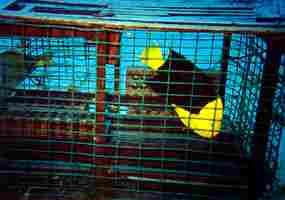
Ornamental fish in trap. Photo by Don DeMaria
Causes of Marine Debris
Deliberate disposal is the single biggest factor to the enormous quantities of waste in our waters.
Boaters Dump plastic domestic items such as bags, six-pack connectors, containers, tampon applicators, pieces of styrofoam, and galley waste.
Fishermen -- Dump plastic buoys, rope, nets, traps, and monofilament fishing line.
Cruise Ships -- Dump domestic waste, and plastic serving materials.
Cargo Ships -- Dump plastic strapping bands, large sheets of plastic, and domestic waste.
The Law -- It is illegal for any vessel to dump plastic trash anywhere in the ocean or navigable waters of the United States. Annex V of the MARPOL TREATY is an international law for a cleaner, safer marine environment. Violation of these requirements may result in a civil penalty up to $25,000 and imprisonment. If you witness a violation and report it, you may receive a reward.
If the biota, in the course of aeons, has built something we like but do not understand, then who but a fool would discard seemingly useless parts? To keep every cog and wheel is the first precaution of intelligent tinkering. Aldo Leopold, Round River, 1993.
Reef Relief Founders.com


